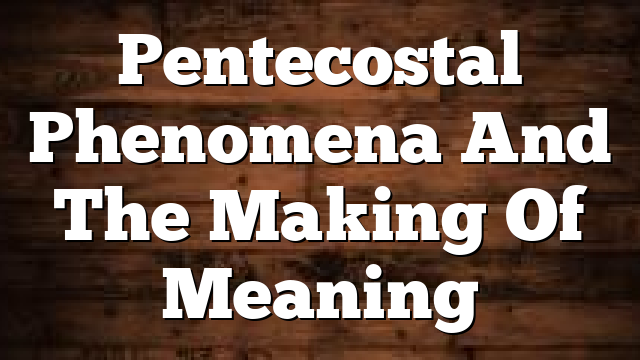Click to join the conversation with over 500,000 Pentecostal believers and scholars
Click to get our FREE MOBILE APP and stay connected
| PentecostalTheology.com



PNEUMA 40 (2018) 283–286
Pentecostal Phenomena and the Making of Meaning
Pentecostal phenomena consist of a repertoire of everyday practices and knowledge that make life meaningful for those involved. Glossolalia, healing, deliverance, dreams, and visions infuse the pentecostal life world, but while they may assume similar structure and form across contexts, they are made meaningful in each context in ways that are distinct and then deployed, inten- tionally or unintentionally, to achieve particular results. In one setting, pente- costal practices may be used to reinforce the social order and its institutional leaders,but in another settingthese practicesmaybe used in subversiveways.A word of prophecy may, for instance, reinforce the authority of the charismatic leader, community, or institution; or prophecy may subvert in a different con- textandforcegroupmemberstonavigatethedisruption.Generally,though,the meaning of any given phenomenon constitutes a mix of the two as it plays out in the social context. Thus, pentecostal and charismatic phenomena are pro- duced, expressed, and made meaningful as they are applied to different and varied social situations across the globe.
The same could be said about pentecostal sources of knowledge as well. Reading and interpreting Scripture is a process that generates meaningful understanding and can be used to maintain social order and its leadership. But the reading and interpreting of Scripture can also be used to subvert social order. Postcolonial and empire interpretations highlight the subversive ele- ments in Scripture that challenged the oppression of the Roman empire, as Richard Horsley has ably shown. Scripture is often quoted to support or chal- lenge the social order in ways that differ across contexts. Theologizing also follows this pattern in that reflection on God-talk may support the social order, but it can just as easily subvert it depending on how it is deployed. Prophet, priest, and king are biblical types used by theologians to demonstrate how the socialor religiousorderis subvertedor maintained.While king and priestmain- tain order, the prophet challenges and disrupts it for the sake of a higher calling. The point is that meaning is not essentialist, but socially constructed and main- tained in the repertoire of phenomena and knowledge.
Joseph Florez’s anthropological study of Chilean pentecostals under mili- tary dictatorship shows how localized and unstable everyday practices, even
© koninklijke brill nv, leiden, 2018 | doi:10.1163/15700747-04003027
1
284
althouse and waddell
when less traditional or idiosyncratic, were necessary innovations to sustain their faith. Specifically, the Misión Iglesia Pentecostal in Chile originally had ties to the Communist Party, but after a military coup and subsequent dicta- torship the church members had to learn to survive in the new regime, even as they face human rights abuses. Florez argues that these Pentecostals con- structed religious experience in ways that expanded beyond conventional and traditional expressions, as outward expressions navigating the tension of living under difficult circumstances of authoritarian rule. Their religious experiences internalized the meanings and practices of resistance and solidarity even in the face of torture or death, by drawing on a history of marginalization for innovative ways of expressing Christian responsibility and defiance. Support- ing subversive political practices was equated with religious duty. Everyday pentecostal practices such as prayer, while appearing traditional, were acts of subversion and resistance. No distinction was made between participation in socialist activity, solidarity with peers, and calling on God’s power to intervene in difficult situations. Pentecostal phenomena and knowledge therefore easily transcend tensions between traditional meanings and acts of resistance and solidarity, at least in the case of Chilean Pentecostalism associated with Misión Iglesia Pentecostal.
Judith C.P. Lin’s exploration of the charismatic character of Taiwanese Prot- estantism challenged the notion that these churches have been influenced by the charismatic movement since the 1980s, to argue that charismatic ele- ments could be found in Taiwan Protestant churches much earlier in the cen- tury. Analyzing the work of Kou Shih-yuan and Wu Yung, Lin argues that despite their self-identification with Evangelicalism, they accented supernat- ural expressions of the Spirit-filled life such as boldness to preach, healing, demonic deliverance, and speaking in tongues, though with varying degrees of acceptance. Lin also examines issues of theTaiwan Church News, published by the Presbyterian Church in Taiwan, for discussions on supernatural phe- nomena. The results are mixed, with some articles arguing to rationalize or demythologize supernatural phenomena, while other articles testify to dra- matic healings. Lin’s analysis leads her to conclude that rather than a shift to more charismatic elements inTaiwanese Protestantism, it would be more accu- rate to speak of the rediscovery of the charismatic character of theseTaiwanese churches. This comports with the culture of spirit cosmology of the Taiwanese people that could readily accept charismatic elements. Lin does not, however, dismiss the importance of the charismatic movement of the 1980s as it brought stable teaching, fresh awareness, and able leaders to solidify charismatic theol- ogy in Taiwan.
Uchenna D. Anyanwu proposes a pneumatological path for buildingshalom in the relationship between Christians and Muslims. After discussing the
PNEUMA 40 (2018) 283–286
2
editorial
285
various understandings of spirit in Islam that include the association of spirit and angels, especially Gabriel, revelation and inspiration of Allah, and the spirit of holiness associated with Jesus that made him unique among the prophets, Anyanwu argues that a Christian understanding of the Spirit of peacebuild- ing can be developed through the Christian lens of the missio Dei. The Spirit not only establishes the church and draws people in to participate in triune mission, but the Spirit also engages people of other faiths through God’s ini- tiation in mission to the world. Peacebuilding is a proactive and intentional process of creating the parameters of peace, rather than peacemaking as a response to a crisis of conflict, violence, and war. Peacebuilding nurtures the relationships and structures for shalom. Employing the Spirit-dove metaphor, Anyanwu argues that the Holy Spirit is the Spirit of peace, who is sent to cul- tivate reconciliation of the whole cosmos. Anyanwu then points to three ways in which peacebuilding could be developed. One is through the Spirit’s use of dreams and visions as a means of divine encounter. Another draws on James D. Hunter’s practice of faithful presence that requires Christians and Mus- lims to be involved in the lives of the other as a form of incarnational living. Finally, peacebuilding should make use of technology and arts as a means for engagement. Anyanwu’s proposal is a needed breath of fresh air in the current world, in which rhetoricof conflict and global hostilities aredestabilizing world peace.
Anna Marie Droll explores the phenomena of dreams and visions in West Africa andTanzania through the theological lens of pneumatology. Specifically, she argues that dreams and visions are existential samples of the pneuma- tological imagination as articulated by Amos Yong and Nimi Wariboko. Droll draws on Yong’s trilectic hermeneutic of Spirit-Word-community by which the human mind, enlivened by the Spirit, is able to discern the legitimacy of reli- gious experience. In the African context, theological assessment of dreams and visions is cast along a continuum of indigenous religious experience and pentecostal religious experience. Moreover, she employs Yong’s concept of the pneumatological imagination to assess the validity of these phenomena as con- temporary expressions of the Spirit and to assess their value for congregational life. Droll also draws on Wariboko’s concept of the pneumatological imagina- tion, which argues for the recontextualization of African dreams and visions through a hermeneutic of spiritual warfare as a pentecostal way of knowing what is real. One must pierce the veil of phenomenology to know the real. According to Droll, piercing the phenomena to perceive what lies behind is how her African informants imagine the world, a perception that leads to the construction of a political theology informed by dreams and visions. In Africa, dreams and visions are common phenomena that are enfolded into the African
PNEUMA 40 (2018) 283–286
3
286
althouse and waddell
pentecostal understanding of what is real, and the ways in which Africans inter- pret these phenomena potentially aid in theological construction.
The history of biblical interpretation and the effects of those interpretations is the subject matter of reception history, a methodology that Martin W. Mit- telstadt introduces and advocates in a final review essay. To paraphrase Luke Timothy Johnson, reception history focuses on the world that the Bible pro- duced rather than on the world that produced the Bible. Mittelstadt focuses on the reception history of Luke-Acts, a paradigmatic text for Pentecostals. Recep- tion history, as Mittelstadt notes, includes a history of exegesis but is not limited to a history of literary interpretation and may include the effects on various aspects of society, including music, art, politics, architecture, literature, pop culture, and the like. After an autobiographical introduction to the methodol- ogy, Mittelstadt reviews the Ancient Christian Commentary on Scripture(edited by Thomas Oden), Reformation Commentary on Scripture (edited by Timothy George), Illuminating Luke (3 volumes, by Heidi J. Hornik and Mikeal C. Par- sons), The Acts of the Apostles through the Centuries (also by Hornik and Par- sons), and The Acts of the Apostles: Four Centuries of Baptist Interpretation (edited by Beth Allison Barr et al). Mittelstadt concludes with an appeal for pentecostal scholars to engage the reception history of pentecostal readings of Luke-Acts.
The phenomena of glossolalia, healings, exorcisms, and dreams and visions have, without a doubt, shaped pentecostal identity and given meaning to the adherents of these spiritual communities. In addition to these phenomena, a primary source of knowledge has been—and continues to be—the Bible. Like charismatic phenomena, however, Bible reading is not a neutral activity, nor does it take place in a cultural vacuum. Interpretations of Scripture have been used to bolster the status quo of a community or, at other times, to correct or challenge its authority structures. The role of women in ministry is an example of an issue in which various interpretations have been used on either side of the debate. The goal of pentecostal scholarship is not to sanitize its history, but to analyze it, clarify the different nuances of meaning, and, in some cases, to contribute to its future doctrines and practices.
Peter Althouseand Robby Waddell
PNEUMA 40 (2018) 283–286
4




Most Talked About Today